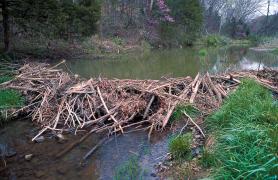
Prior to the creation of the Missouri Conservation Commission in 1936, wildfires often spread uncontrolled across the Missouri Ozarks. It was estimated that nearly a third of the Ozarks burned each year. Wildfire and overharvest of timber left Missouri’s forests in bad shape.
Conservation advocates realized that controlling wildfire was essential to the recovery and overall health of Missouri’s forests. Once the Department of Conservation was formed, George O. White took the role of state forester and began the work of restoring and protecting the Ozarks.
Fire Towers 101
Fire towers were the most effective method of fire detection for decades. In 1941, there were 15 towers owned by MDC. In 1966, MDC operated 102 fire towers, and the U.S. Forest Service operated 43 in Missouri.
Towers ranged from 60 to 120 feet tall, and the style and elevation depended on cost, availability, site elevation, and surrounding topography. Most of Missouri’s fire towers were 100 feet tall and manufactured by Aermotor Company of Chicago. Some towers had catwalks that surrounded the cab at the top. Most were made from steel, but early towers were made of wood. Twelve towers were acquired as surplus military property after having served as observation towers during World War II. A few were former oil derricks with steel ladders instead of stairs. Some did not have cabs at all, but just a platform on top to watch for smoke.
Fire towers were located on high elevations where they provided a 360-degree view of the surrounding country. From the towers, towermen were able to see smoke from wildfires, and then either take action to suppress the fire themselves or report the fire location to other personnel.
Preserving the Memories
Before Forestry Management Chief Mike Hoffman retired from MDC in 2014, he hired two forestry staff retirees to help him with a project he had been thinking about for a long time.
The project documented the history of Missouri’s fire towers and the experiences of the people who spent their careers perched 100 feet in the air, keeping their eyes peeled for smoke on the skyline. What better way to learn about fire tower history than to hear directly from those employees? Hoffman and his team interviewed over 30 employees and recorded their stories. What is captured here are just a few snippets from the hours of audio recordings, highlighting decades of service from dedicated employees.
A Day in the Life at a Fire Tower
Don Rittenhouse
During a typical day in the tower, you saw some smoke, you’d take “a shot on it” by getting a compass reading on an Osborne fire finder. It had an azimuth circle that turned, with a sight on it like a rifle. You’d line it up on the smoke and get a reading and call it in to the dispatcher at the office. The dispatcher had a district map with all the towers. There were strings you could pull from the border of the district map. The dispatcher would get readings from two towers, mark them with the string, where those strings crossed was the location of the fire, within about a 40-acre area. We could shoot it close enough that you wouldn’t have trouble finding it.
Bob Aubuchon
When we talk about “clearing a tower,” it means someone has to go up and take a look from the tower to make sure the fire we’re working on hasn’t broken out across the fire line behind us. Sometimes when we clear a tower, it’s to go up and look around and make sure the surrounding country is clear from wildfire. A lot of times you can tell the difference between a controlled burn or a wildfire just by the nature of the smoke. Not only the color of the smoke, but the volume — if it’s boiling up, if the width is getting wider — that’s a sign it’s probably out of control.
Charlie Santuff
I grew up in Reynolds County, about a mile from the Panther Hill lookout tower. My dad worked on fire duty for the department for many years. When I was about 10 or 12, my dad started taking me up in the tower. It was a 65-foot wooden tower with a catwalk around the cab. By the time I was 14 or so, I was manning the tower when the crew would take a fire run. They’d pay me 35 cents an hour, but I didn’t have a social security card, so they put it on my dad’s check. I continued working during fire seasons through high school, when I decided I wanted to be a forester. I got my degree from MU and worked for the department for 33 years.
Bob Aubuchon
Ed Christopher was a towerman for about 38 years. Ed often worked the Kelleter tower as a team with his wife, Wilma. It wasn’t uncommon for Wilma to go up in the tower and clear it if Ed was out working on a fire. In early days, Ed would take a shot from the Kelleter tower, drive over to the Lone Hill or Onyx Hill towers and take another shot, cross the fire out himself, and then go out and fight the fire.
Shenanigans, Vandals, and Odd Occurrences
Darrell Burkhart
I worked on the Meramec District starting in 1967. I lived with my wife at the lookout tower, which had its own tower house. Every so often I’d wake up in the middle of the night because kids would climb up in the tower and make lots of noise. They’d be up there screaming and hollering, and I’d have to go tell them to quiet down and leave. I never had any serious problems, as most people were very courteous.
One night I was working dispatch and there was a pretty good-sized fire. The phone rang, and the person said he was “Major So-and-So” from NORAD in Colorado Springs. He said one of their satellites had picked up a large heat source southeast of my location. I relayed that it was a large, controlled fire and the guy thanked me and hung up. Once I got to thinking about it, I almost fell out of my chair. That was back in the day when you didn’t really think about satellites circling around and tracking everything.
Duane Parker
The funniest situation I ever encountered was at the Bloomfield tower in the Bootheel. When I arrived, I discovered it had been painted from top to bottom in a rainbow of colors. Every step, every landing was a different color of enamel paint.
The artists had carefully initialed their work on the top step. Since it was close to graduation time, I stopped by the Bloomfield School District office to see if the superintendent recognized the initials. He did, and the two students confessed once they were brought to the office. They spent the next month of weekends removing paint from the tower. They used hundreds of sanding discs, tons of brushes and scrapers, and paint remover, and they cleaned it all. It probably looked better than it had for years when they were finished.
The Worst Fire in Memory
Darrell Burkhart
The worst fire season was the summer of 1980. It started in the fall of 1979, because we didn’t get any fall rain, very little snow that winter. But by the end of June, everything was dry as popcorn. We had some days in Neosho with single digit humidity, and that’s just unheard of in this part of the country. We’d see farmers brush-hogging, and they’d hit a rock and it would spark and set the grass on fire. Lightning would strike the ground and set fields on fire. That was stuff that just didn’t normally happen. One stretch that summer we worked seven weeks without a day off.
Don Rittenhouse
We had a lot of them in the 1950s and 1960s. The fire in 1980 was probably the worst. We called it Black Tuesday. We had a fire south of Hollister, on the east side of the railroad track with a southwest wind behind it. Fuel was bluestem, cedars, lots of dead snags, timber, all uphill. We had practically every unit on the district there. The property was 7,200 acres, and 3,100 acres burned until we got it corralled.
Equipment and Changing Technology
Dave Fenstermaker
You’d communicate back and forth with two-way radios. They weren’t like they are now — there was just one frequency for each radio, one radio channel for each district. They were mounted in the tower’s cab because they weighed about 100 pounds each. Later on, we got handheld portables, but they still weighed 30 pounds. They were heavy to carry around, but you could take them home with you. The wife and kids would get aggravated because it would rattle on all night long.
Fire Towers Today
Many fire towers, especially wooden ones, were taken down in the 1980s as the wood decayed and aircraft were used more often for fire detection. In fact, by 1970, fire towers only accounted for about 40 percent of detected wildfires throughout the state. By the 1990s, that dropped to less than five percent.
Fire towers have not only been replaced by aircraft and cell phones, but the need for them has also declined, as Missourians do a much better job of landscape management and fire prevention. Landowners understand the value of forest management, prescribed burns, and other efforts to keep wildfire from happening in the first place. Local volunteer fire departments have access to training and equipment that prepare them for a quick response to wildfire.
MDC still has about 50 fire towers on department property, but they no longer need full-time staffing during fire season. In fact, most staff may only climb a tower a few times per year, on high-risk days or as needed to help pinpoint a fire location.
From the late 1930s through the 1960s, fire towers were the most important tool for fire detection in Missouri. Managing the health of Missouri’s forests and woodlands was not possible without controlling the rampant wildfires in the state. In a way, these towers are responsible for the healthy forests we enjoy today.
Learn More
Bob Frakes has had a passion for the history of Missouri’s fire towers for years. Frakes collected photos of fire towers, equipment, and some personal stories from the families who worked the towers in his book, Remembering Missouri’s Lookout Towers: A Place Above the Trees. He also helps maintain an online Google map of Missouri’s fire towers, which can be found by searching for Missouri Fire Towers Active Map. For more information, visit short.mdc.mo.gov/4i4.












Also In This Issue

Missouri’s original landscapers and engineers

The dangers of being confused for your “evil” twin
And More...
This Issue's Staff
Editor - Angie Daly Morfeld
Associate Editor - Larry Archer
Photography Editor - Cliff White
Staff Writer - Kristie Hilgedick
Staff Writer - Joe Jerek
Staff Writer – Dianne Van Dien
Designer - Shawn Carey
Designer - Marci Porter
Photographer - Noppadol Paothong
Photographer - David Stonner
Circulation Manager - Laura Scheuler






















